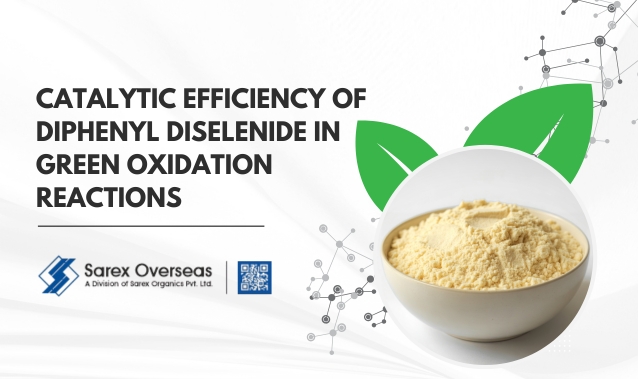Diphenyl Diselenide (DPDS) is being widely recognised nowadays in modern organic chemistry as a very effective catalyst for green oxidation reactions. The catalyst exhibits amazing selectivity and efficiency when using environmentally benign oxidants such as hydrogen peroxide or tert-butyl hydroperoxide.
As industries shift towards green chemical practices, Diphenyl Diselenide offers a greener, safer and more efficient method for carrying out oxidations without sacrificing performance.
This blog goes into its chemistry, catalytic activity, uses and specifications while revealing reasons why it is a crook breaker when it comes to green synthesis.
A Sustainable Catalyst Rebuilding Modern Chemistry
Diphenyl Diselenide is notable for its compromise between strong catalysis and environmental footprint. It facilitates oxidation under mild conditions, necessitating less usage of heavy metals and vigorous reagents. It does not form poisonous side-requisites like many classical oxidation catalysts. Rather, it does a neat conversion with water being the prominent trash output.
Low catalyst loading, especially notable, adds to the high measure of greenness of Diphenyl Diselenide. This makes it suitable for laboratories and industries that wish for performance yet are environmentally conscious.
Chemically, Diphenyl Diselenide is C₁₂H₁₀Se₂ and has a molecular weight of 312.13 g/mol.
Here, it is referred to by some names like 1,2-Diphenyldiselane or (phenyldiselanyl)benzene and it exists as a yellowish crystalline powder with a melting range of 59.0°C to 64.0°C. It dissolves easily in acetone and shows a high assay purity of not less than 98% (GLC), ensuring consistent catalytic activity in every batch.
Why Diphenyl Diselenide Enhances Green Oxidation Better?
The specific effectiveness of Diphenyl Diselenide is due to its capability for selectively transferring oxygen to target molecules. It activates oxidants such as hydrogen peroxide, which creates reactive intermediates that reduce sulphides to sulfoxides without over-oxidising them into sulfones.
This is a time, energy and resource saving controlling reaction. Besides alcohol oxidation to carbonyl compounds, Diphenyl Diselenide also catalyses olefin epoxidation under benign, metal-free conditions.
Its catalysis involves the temporary oxidation of DPDS into seleninic acid or peroxy-seleninic intermediates, which deliver oxygen to the substrate prior to the regeneration of the original diselenide. This self-regeneration maintains the system active for several cycles, increasing reactions for being quick as well as cheaper.
Supporting Reusability and Scaling Innovations
Sustainability of catalysis relies on reusability and Diphenyl Diselenide does not disappoint. Scientists have managed to immobilise it on recyclable materials like magnetic chitosan or supported silica. This easy step makes it simple for chemists to isolate and recover the catalyst, minimising solvent usage and general waste.
Partner with Sarex for Reliable Supply
Reliable sourcing is key to achieving consistent catalytic performance. Sarex offers high-purity Diphenyl Diselenide for special green chemistry uses. A prominent bulk manufacturer and exporter of fine and textile chemicals based in India, Sarex makes quality go hand in hand with innovation.
For companies seeking to make oxidation processes greener, faster and more efficient, there is the go-to company for reliable supply, expert advice and scientific backup: Sarex.

